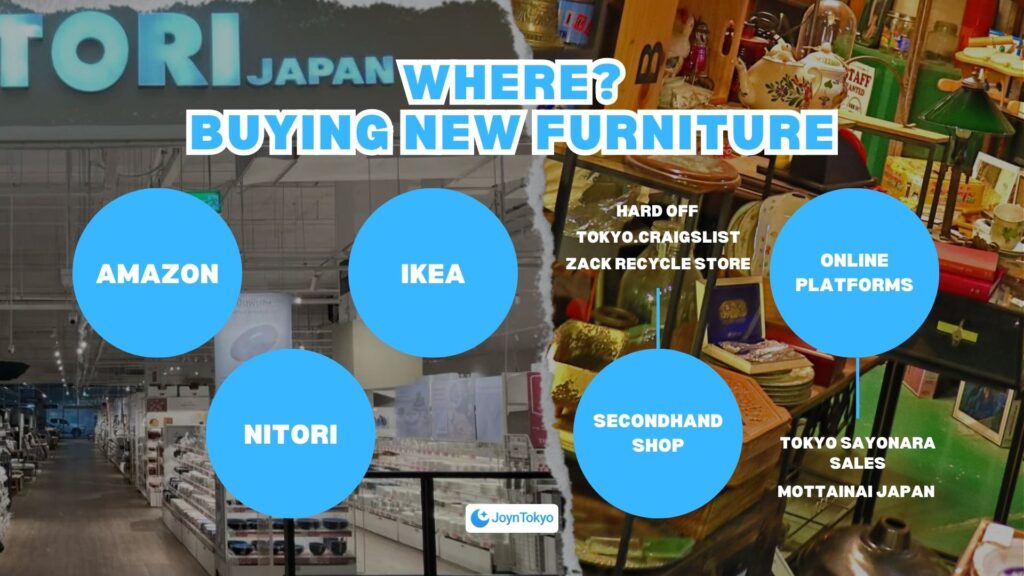You’ve just signed your lease and walked into your new place in Tokyo — only to find it completely empty. Don’t worry: this is common in Japan, where many apartments come unfurnished. But how do you transform that bare space into a cozy home without breaking the bank? In this guide, I’ll share my personal tips on shopping for new furniture, snagging secondhand deals, and even getting freebies from friends or coworkers.
Buying New Furniture

Sometimes, going brand new is the simplest option. While it can be more expensive, there are convenient stores and online outlets that cater to every style and budget. Here’s how to find the right pieces for your Tokyo apartment.
Ordering Online
In Japan, Amazon and other online retailers are reliable options. Appliances like rice cookers and kettles are often good picks to order online because you usually know the size and specs in advance.
However, for large items such as beds, sofas, or refrigerators, seeing them in person first is a smart move. You don’t want to end up with a couch that’s too small or a fridge that barely fits your kitchen. That’s where physical stores come in.
Shopping In-Store
If you need to test out a mattress or visualize a sofa in your living room, head to a furniture store.
- Nitori: Perhaps the best-known furniture chain in Japan, Nitori carries everything from refrigerators to cushions. I vividly remember my first trip: I bought trash cans (waste separation is crucial in Japan), poles for drying clothes, and even a bracer pole to hang clothes in my closet. I also ordered a sofa and a kotatsu (heated table) for winter.

- Ikea: If you’re an IKEA fan, you’ll find several stores around Japan. Do note that some moving companies consider IKEA products lower quality compared to Japanese brands. A friend once had his mover refuse to handle IKEA pieces because they often broke in transit.

When buying large items in-store, you can usually arrange a delivery date with the staff. Be aware that English-speaking staff may be limited, so bringing a Japanese-speaking friend or using translation apps can help.
Buying Secondhand
For those on a budget — or simply looking to score unique finds — secondhand shops and online marketplaces are great alternatives. Used furniture in Japan can be surprisingly high-quality, often due to frequent appliance upgrades and short-term stays.
Exploring Recycle Shops
Tokyo is full of “Recycle Shops,” where people buy and sell used household goods. One of my favorites is Zack, a small chain offering a rotating selection of items. I snagged my TV, microwave, washing machine, and refrigerator here. If you spend over a certain amount and live within a certain distance, many shops offer free delivery.
During my last purchase, the delivery guys came at the end of the day. I offered them a beer as a thank-you — though they turned it down with a friendly laugh, as tipping and gifting culture in Japan is quite different from Western norms.

Online Platforms
Despite feeling like a throwback, Craigslist can still be handy for finding cheap or even free items in Japan. I scored Laura Ashley curtains and a bath cover from someone leaving the country.
Facebook groups and other social media platforms also host “Sayonara Sales,” where people departing Japan sell their goods at discounted prices. Remember, there’s no buyer protection, so verify condition beforehand. Still, it’s a fantastic way to pick up bargains while helping someone declutter before a move.
Asking Friends and Colleagues
Don’t underestimate the power of simply telling people you’re furnishing your new place. Chances are someone has spare plates, glassware, or small appliances gathering dust. I received cutlery and extra kitchen items from colleagues when I moved, which saved me both time and money.
Similarly, when people move out of share houses or small apartments, they sometimes leave behind items they can’t use anymore. That’s how I ended up with a handy mini kettle — perfect for my kitchen.
Final Thoughts
Walking into an empty Tokyo apartment can be overwhelming, but furnishing your space doesn’t have to be. Whether you opt for brand-new pieces, secondhand treasures, or freebies from friends, there’s always a way to adapt your home to your style and budget. With a bit of planning and flexibility, you’ll soon transform that bare floor and bare walls into a comfortable place you’ll be happy to call your own.


